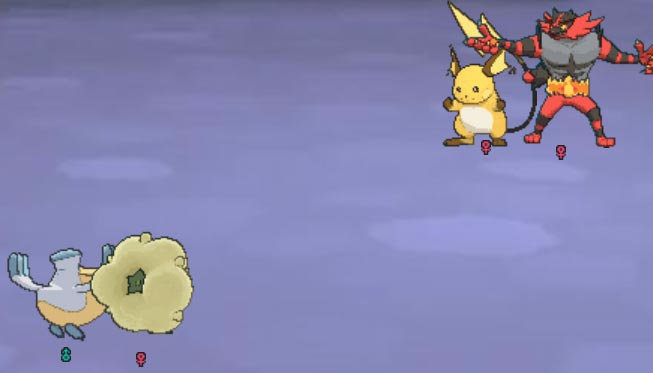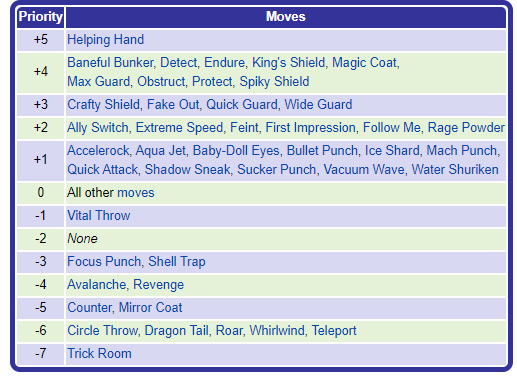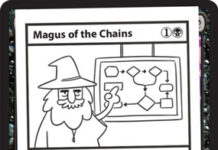Source credits and thanks: Bulbapedia (table), ShineyAltaria (reviewer), and Pojo!
First of all, thank you for visiting this page. Chances are, if you’re here, you’re a Pokemon Player who has done almost anything possible with the game: shiny hunting, trading, getting a living dex, maybe even a fully legit living shiny dex (TriHard), but not competitive battling. Well, this guide is tailored specifically for that topic: competitive Video Game Championship (VGC) battles in Pokemon Sword and Shield. This is a battle format that takes traditional Pokémon battling to a whole new level! It is a battle of wits, manipulation, bluffing and out-predicting your opponent. It’s a test of your ability to manage information and optimize your path to victory. And it’s hella fun to play! And if you’re totally new to this, don’t worry; we’ve got you covered with the basics with this handy guide.
-
Know the rules:
While the specifics of the rules vary from season to season, there are a few fundamental rules that form the backbone of the VGC format:
- Battles are held in the doubles format, where each player brings 4 Pokémon to battle, from a team of 6.
- Players have a 90 second team preview phase before each battle, during which each player’s teams of 6 Pokémon are revealed (held items are not revealed), and players have to choose which 4 Pokémon to bring within that time limit.
- Apart from mythical Pokémon, a team can consist of almost any Pokémon, and if the season permits, restricted Pokémon (box legendaries) as well.
- Only the species clause (no two of the same Pokémon species per team) and item clause (no two Pokémon having the same held item) are in effect. Other smogon-specific clauses you may be aware of, such as the evasion or sleep clause, do not apply.
- To compete, head to the Battle Stadium on a copy of Sword or Shield, and select Ranked Battles.
-
Dynamics of Double Battles
So you’ve beaten the entire game and feeling good about your skills in Pokémon, but when you step into the world of competitive, it suddenly feels like a totally different game. That’s because the predominantly in-game single battles do not prepare you nearly enough for the double battles that Pokémon (un)ironically chooses to have as its official format. So what is different besides there being two Pokémon on the field on each side? The best way to understand how this works is by diving in to an actual battle scenario. Suppose the following Pokémon are on the field.

Let’s analyse the possibilities of what could happen within the next turn or two using the following framework.
- Analyze threats coming from your side and coming from the opponent’s side.
Our Whimicott walls the opposing Raichu and our Pelipper threatens the opposing Incineroar with a huge rain-boosted water move. However, Raichu threatens Pelipper and Incineroar threatens Whimsicott. Such crosstalk between the type matchups of four Pokémon is a staple complexity of VGC that is not present in singles, and an experienced player must know how to identify and handle this if he/she wants any measure of success.
- Speed Tiers
With 4 Pokémon on the field, the order in which Pokémon make their moves is crucial in determining the outcome of the game. This order is based on the speed stat of each Pokémon. Pokémon with a higher numerical speed stat move first, and in the case of a tie, the game does a coin-flip decides who goes first. Of the four Pokémon on the field, Whimsicott being the fastest moves first, followed by Raichu, then Pelipper and then Incineroar. This poses a problem for us. While Whimsicott may move first to inflict damage onto either the opposing Raichu or Incineroar, it does not threaten a knockout (KO) on either of them. Raichu moves next and has the opportunity to KO Pelipper before it can launch a water-move at Incineroar. With Pelipper KOed, Incineroar has an easy time dealing with Whimsicott. What seems like a fair matchup is actually losing for us! Speed tiers make or break a battle, and it is essential to know the different speeds of Pokémon.
- Speed Control
Thankfully, turn order can be manipulated during the battle. Wouldn’t it be good if the Pelipper could move before the Raichu and KO Incineroar before it gets taken out by an electric move? That can happen if Whimsicott uses Tailwind. Tailwind is one of many speed control moves that manipulate the speeds of the Pokémon on the battlefield, allowing some Pokémon to move first when they otherwise would not. So now, Whimsicott uses tailwind, making Pelipper move before the Raichu, allowing it to knockout Incineroar before it faints to en electric move, forcing a 1 vs 1 between Whimsicott and Raichu that Whimsicott will win. For more speed control options, check out section 3 below.
- Priority
To make things even more dynamic, there is priority. Priority moves are moves that bypass speed tiers to always go first, with moves of higher priority going before lower ones. In our situation here, both Raichu and Incineroar have access to a move Fake Out. Fake Out is a move that works only on the first turn the Pokémon has been sent out, and not only has high priority but also makes the target flinch, rendering it immobile for the rest of the turn. This means that Whimsicott could be hit by a fake out by Incineroar, flinch and not get Tailwind set up, allowing Raichu to KO Pelipper first. Or, the Fake Out could land into Pelipper instead, allowing Raichu to KO it even if Tailwind gets set up. For more information on priority, check section 3 below.
- Protect
One staple move that deserves special mention is Protect. Protect goes before almost any other move and serves to prevent the user from the effects of moves targeted against it for that turn. A single well-timed protect can swing the battle and turn a losing match into a winning one. In our battle, Pelipper could protect against the Fake Out on Incineroar, as well as the attack from Raichu, while Whimsicott sets up Tailwind, and is then free to outspeed the Raichu and KO the Incineroar the next turn.
These are just some of the most important things to consider in Pokémon double battling that any beginner should be aware of when crossing over from a primarily singles format. However, the discussion so far forms just the tip of the iceberg. Other aspects have not been addressed, such as:
- How are each of the Pokémon trained? EV, IV and natures determine both offensive and defensive outcomes and influence the decision-making process. This guide assumes that the reader knows what these are and will not discuss them.
- What are the held items of each Pokémon? A single held item can turn the battle around, such as an Assault Vest or Passho Berry on Incineroar, allowing it to survive a water move.
- What moves do these Pokémon usually have? Knowing which moves you can expect on an opponent’s Pokémon based on what is trending in the metagame can greatly facilitate the prediction process. Do Incineroar commonly run Protect? Will we be wasting a turn attacking into a protecting Incineroar as a result?
- Dynamax: What Pokémon are common Dynamax options? In what position is the opponent likely to Dynamax? When and what Pokémon should I Dynamax?
- How can I make reads on what the opponent is trying to do?
- How can I build a good, well rounded team, and how can I position the Pokémon optimally to play towards the functioning of the team?
These aspects may be briefly touched on in this guide, but is beyond the scope of a beginner’s guide to VGC. They may be the subject of future articles posted here.
-
Know the different types of moves
Moves that dish out large chunks of damage (with or without secondary effects) are always cool to have, but other types of moves, such as support moves, priority moves and spread damage moves are arguably just as important, if not more important, than the good old Hyper Beam you enjoyed spamming in Pokémon Red when it did not need to recharge. Over here, we’ll give you a list of these other common types of moves that you might run into when battling in this format.
- Speed control:
- Tailwind
Tailwind doubles (2x multiplier) the speed of both your Pokémon for 4 turns. Using this move would allow Pokémon with middle speed tiers to outspeed even the fastest of all Pokémon (such as allowing Kyogre to outspeed a Regieleki). Tailwind is commonly used on Pokémon with Prankster that increases the priority of status (non-damaging) moves. What this ensures is that Tailwind gets set up on your side at the beginning of the turn allowing your partner Pokémon to move immediately after.
Pokemon with Tailwind:
Whimsicott, Tornadus (with Prankster)
Suicune, Latios, Latias, Crobat
- Max Airstream
Max Airstream is a move used by Dynamaxed Pokémon that increases the speed of both your Pokémon by one level (1.5x multiplier). You will need two Max airstreams to achieve the same speed increase as Tailwind, but since this is a stat modifier, the changes are permanent, and remain in effect until the Pokémon leaves the field. This move is however only accessible in Dynamax VGC formats.
Pokémon that use Max Airstream:
Galarian moltres, Landorus-T, Thundurus-I, Charizard
- Trick Room
Trick Room is a move that reverses the speed order of Pokémon for 5 turns. During these 5 turns, the Pokemon with slower speed stats move BEFORE Pokémon with a faster speed stat (for example, Torkoal moves before Regieleki). It allows slower Pokemon such as Calyrex-Ice, Torkoal, Ferrothorn and Stakataka to become huge offensive threats. Setting up Trick Room is often a challenge, as the move always goes last every turn (even for Pokémon with Prankster), allowing for the Trick Room setter to get KOed before it can set it up. As such, the partner Pokémon is essential in helping the Trick Room setter set up Trick Room. How to effectively use this strategy, as well as building a team around it, or countering teams that use it, will be the subject of another article.
Pokemon with Trick Room:
Porygon2, Oranguru, Stakataka, Calyrex-Ice, Indeedee-Male, Necrozma, Hatterene
- Thunder Wave
Thunder Wave paralyzes the target Pokemon, halving its speed stat (x0.5 multiplier) and making it have a 25% probability of being unable to move each turn. If used by a Pokemon with Prankster, Thunder Wave is a good way to cripple opposing fast Pokémon. Do note that ground types as well as electric types cannot be hit with Thunder Wave, as well as if there is a Lightning Rod user on the field.
Pokemon with Thunder Wave:
Grimmsnarl, Thundurus-I (with Prankster)
Gyarados, Porygon2, Zapdos
- Electroweb and Icy Wind
These are spread special attacks that hit both opposing Pokémon and lower their speeds by one stage each (x0.6666 multiplier). A fast user of these moves, such as Regieleki, can lower opposing Pokémon’s speed allowing its ally to move next in line.
Pokemon with Electroweb:
Regieleki, Tapu Koko, Thundurus
Pokemon with Icy Wind:
Suicune, Milotic, Tornadus-I, Gengar, Weavile, Kyurem-White
- Bulldoze
Bulldoze is a spread ground move that hits all Pokémon on the field (including your ally, except for flying-types or levitating Pokemon), and lowers the speed by one stage of all Pokémon hit. A common secondary use of Bulldoze would be to use it to activate a Weakness Policy item on your ally, allowing it to sweep.
Pokemon with Bulldoze:
Entei, Spectrier, Bronzong, Dusclops
- Max Strike
Though not a common form of speed control, Max Strike comes into play on Porygon-Z and Regigigas teams, where both these Pokémon do devastating Normal-type damage with their huge special and physical attack stats respectively. Its secondary effect is to lower the speed of both opposing Pokémon by one stage each. As such, as a last ditch attempt at a clutch victory, one may also consider Dynamaxing a Pokemon just for the purpose of getting this move off to lower the opponent’s speed.
Pokemon with Max Strike:
Regigigas, Porygon-Z, Spectrier, Regieleki
- Priority
The subject of priority needs to be delved into sufficient detail. What priority generally refers to is the ability for a move to be launched before other moves, regardless of the speed stats of the Pokémon involved. The priority a move gets is divided into brackets, ranging from -7 to +5. Refer to the following table showing the different priority of moves.

|
*Grassy Glide gets +1 priority when used in grassy terrain. *Prankster ability increases the priority of status moves by one. *Triage ability makes all healing moves used have a priority of +3. |
The general principle is that moves with a higher priority bracket get launched before moves of a lower priority bracket, regardless of the speed stats. Speed stats refer to the numerical speed stats of the Pokemon, after stat modifiers and status conditions have been taken into account. Speed stats operate independently of priority if moves of different priorities are used. However, if moves of the same priority are used, speed stats will determine which move goes first.
To explain this concept, suppose there is a Rillaboom and a water Urshifu on the field. Grassy terrain is set up. Rillaboom gets access to Fake Out (+3 priority) and Grassy Glide (+1 priority in grassy terrain). Urshifu gets access to aqua jet (+1 priority). As far as speed tiers, Urshifu has a faster speed stat than Rillaboom, and will move first in the absence of any priority moves being used.
Scenario 1: Urshifu uses Close Combat and Rillaboom uses Wood Hammer
Since Urshifu is faster than Rillaboom and both moves selected are in the same priority bracket (+0 priority), Close Combat goes before Wood Hammer.
Scenario 2: Rillaboom uses Fake out and Urshifu goes for Aqua Jet or Close Combat
Even though Urshifu is faster than Rillaboom, Rillaboom’s move has a higher priority than any of Urshifu’s. Hence, Fake Out goes first.
Scenario 3: Rillaboom uses Grassy Glide and Urshifu uses Aqua Jet.
Again, since both moves are at +1 priority, speed stats determine the order. Urshifu moves first.
Scenario 4: Trick Room is set up, and Rillaboom uses Grassy Glide while Urshifu uses Aqua Jet.
Because Trick Room is set up, Rillaboom (which is slower outside of Trick Room) now moves before Urshifu. Though both moves have the same priority, Rillaboom’s attack goes first.
Scenario 5: Trick Room is set up; Rillaboom uses Wood Hammer while Urshifu uses Aqua Jet
Though Rillaboom outspeeds in Trick room, Urshifu is using a move that has a higher priority. Urshifu moves first.
Psychic Terrain (Indeedee, Tapu Lele, Queenly Majesty (Tsareena) and Quick Guard (Talonflame, Mienshao, Pheromosa) prevent priority moves from being launched onto the opposing side of the field. However, one can still use priority moves that affect their own side of the field, such as a Prankster Tailwind or Protect.
- Common priority moves
Fake out
Fake out has +3 priority and can be used only on the first turn that the user has been sent out on the field. If the user has been withdrawn and is sent back out at a later stage, it can use Fake Out again. Fake out causes the target to flinch and not move for the remainder of the turn, making this move instrumental in turning battles around. Being a normal type move, it does not work on ghost types.
Pokemon with Fake Out: Incineroar, Rillaboom, Ludicolo, Weavile, Blastoise, Hitmontop
Protect
Protect has +4 priority, and protects the user from the effects of almost all moves for the remainder of the turn. The utility of this moves stems from allowing one Pokémon to defend itself while allowing the partner Pokémon to knock out opposing threats, or to switch out to maintain pressure, or simply to stall out Tailwind, Dynamax or Trick Room turns (when they aren’t in your favour). Attacking into a protecting Pokémon can lose you a lot of momentum. Almost any Pokémon may run Protect, making this a move you have to watch out for on most opposing Pokémon.
Protect does not grant a Pokémon invulnerability to all moves. Max moves still do a quarter of their usual damage output into a protecting Pokémon, and still have their secondary effects applied. The move Feint (+2 priority) also bypasses protect, lifting the protection and making the protecting Pokémon vulnerable to any other subsequent move targeted at it. Common feint users include Mienshao, Raichu and Hitmontop.
It is also worthy to note that Protect may fail if used in consecutive turns. The second time it is used consecutively, the chances of it succeeding is only 33%, and this probability continues to go down each successive turn.
Other Common Priority moves:
- +1 priority moves:
Aqua Jet- Azumarill, Urshifu-Water
Bullet Punch- Scizor, Metagross, Lucario
Ice Shard- Mamoswine
Mach Punch-Conkeldurr
Shadow Sneak-Mimikyu, Shedinja
Sucker Punch-Cinderace, Urshifu-Dark, Yveltal, Hitmontop
Grassy Glide (only in grassy terrain)- Rillaboom, Tsareena
Any status move used by a Pokemon with Prankster has a +1 priority, but will not work on Dark Types
Pokemon with Prankster: Sableye, Whimsicott, Tornadus, Thundurus, Grimmsnarl, Liepard, Riolu
- +2 Priority moves
Feint- Mienshao, Raichu, Pheromosa
Extreme Speed: Entei, Dragonite, Rayquaza, Arcanine
- Redirection
Redirection moves serve to mess up the targeting of Pokémon: Using these moves will cause an attack to not land on its intended target. These moves are at +2 priority, making them go before most other priority moves. Spread damaging moves (next section) bypass redirection and hit all Pokémon regardless.
- Follow me and Rage Powder
If a Pokémon uses Follow me or Rage Powder, any single target move from the opposing Pokémon will be redirected to this Pokémon instead, protecting your ally Pokémon from taking damage. This move pairs well to allow partner Pokémon to set up (stat boosting moves, Trick Room etc). Follow Me works more consistently, as Rage Powder does not redirect moves used by Grass type Pokémon, Pokémon with the ability Overcoat, or Pokémon holding a Safety Goggles.
Pokemon with Follow Me: Clefairy, Togekiss, Indeedee female
Pokemon with Rage Powder: Amoonguss, Volcarona
- Ally Switch
Ally switch (+2 priority) swaps the position of you and your partner, messing up the targeting of moves used against your side. Ally Switch is notoriously known for invoking 50-50 scenarios in a game that is already riddled with mind games. It takes skill to know when to expect an ally switch from your opponent and thereby target the opposing Pokémon accordingly; knowing the scenarios that would make it more or less likely for someone to click ally switch is the mark of an experienced player.
Pokemon with ally switch: Dusclops, Porygon2, Rotom, Shedinja, Tapu Lele, Chansey
- Spread Damage
Tying in well with the previous section on redirection are moves that do spread damage. Some moves hit both opposing Pokémon, other moves hit all other Pokémon including your ally. In addition to bypassing redirection moves, spread damage allows you to deal damage on both Pokémon, allowing you to pick up multiple knockouts with a single move.
The power of such moves reduces to 75% of its original power when it is launched at multiple targets (to prevent it from being a broken mechanic). This means a 120 base power Precipice Blades when targeted at opposing Pokémon will have an effective base power of 90 on both Pokémon, even if it misses one of the two Pokémon. However when there is only one Pokémon on the other side of the field (if its partner is fainted, for example), that Pokémon will receive the full 120 base power damage. Thus, keeping two Pokémon on your side of the field at all times to mitigate spread damage from the opposing side is something to take into account.
Wide guard (+3 priority) is a move that protects both Pokémon from exclusively spread damage. Unlike protect, it can be used in succession without failing, and serves to deter the trigger-happy clicking of spread moves.
Common Spread damage moves:
Water Spout: Kyogre, Blastoise, Jellicent Origin Pulse: Kyogre
Muddy Water: Tapu Fini, Ludicolo, Kingdra, Milotic, Gastrodon Precipice Blades: Groudon
Earthquake: Landorus, Metagross (Do note that Earthquake also targets your ally)
Rock Slide: Groudon, Landorus, Stakataka
Hyper Voice: Sylveon,
Heat Wave: Charizard, Zapdos, Torkoal
Eruption: Torkoal, Entei
Glacial Lance and Astral Barrage: Calyrex Ice and Shadow Rider
Wide Guard users: Mienshao, Araquanid, Stakataka, Pelipper
-
Field Effects
Field effects either occur on either side of the field or affect the entire field.
- Tailwind: Doubles Speed on your side for 4 turns.
Pokemon: Whimsicott, Tornadus-I, Suicune, Crobat
- Trick Room: Reverses speed order of the entire field for 5 turns.
Pokemon: Porygon2, Oranguru, Stakataka, Calyrex-Ice, Indeedee-Male, Necrozma, Hatterene
- Light Screen and Reflect: Raises Special Defense and Defense respectively on your side for 5 turns; 8 turns if the holder has a light clay.
Pokemon: Grimmsnarl, Regieleki,
- Aurora Veil: Raises both Defense and Special Defense on your side for 5 turns,
Pokemon: Alolan Ninetales, G-Max Lapras
Weather: Weather is a field effect that applies to the entire field for a duration of 5 turns. Only one type of weather can be in effect each turn, with a new weather overriding the previous weather. Weather is activated by abilities and moves.
- Rain:
Rain can be set up for 5 turns with the ability Drizzle or the move Rain Dance or Max Geyser.
Pokemon with Drizzle: Kyogre, Pelipper, Politoed
Pokemon with Rain Dance: Tornadus-I, Sableye (prankster)
An overview of the effects of Rain is described here:
https://bulbapedia.bulbagarden.net/wiki/Rain#Effects
- Sun:
Sun can be set up for 5 turns with the ability Drought or the move Sunny Day or Max Flare.
An overview of the effects of Sun is described here:
https://bulbapedia.bulbagarden.net/wiki/Harsh_sunlight#Effects
Pokemon with Drought: Groudon, Ninetales, Torkoal
Pokemon with Sunny Day: Whimsicott, Sableye (prankster)
- Sand
Sandstorm can be set up for 5 turns with the ability Sand Stream or the move Sandstorm or Max Rockfall.
An overview of the effects of Sand is described here:
https://bulbapedia.bulbagarden.net/wiki/Sandstorm_(weather_condition)#Effects
Pokemon with Sand Stream: Tyranitar, Hippowdon
- Hail
Hail can be set up for 5 turns with the ability Snow Warning or the move Hail or Max Hailstorm.
An overview of the effects of Hail is described here:
https://bulbapedia.bulbagarden.net/wiki/Hail_(weather_condition)#In_battle
Pokemon with Snow Warning: Abomasnow, Alolan Ninetales, Vanilluxe
Terrain:
Terrains exist alongside weather to influence the field. There are 4 main types of terrains, each activated by an ability or move, and each with its unique effects. Similar to weather, only one Terrain can exist on the field at any one time, with a new Terrain replacing the old Terrain. The effects of Terrain apply only to Pokémon that are not Flying type, and do not have the ability Levitate.
- Psychic Terrain:
Psychic Terrain can be set up by Pokemon with the ability Psychic Surge, or with the move Max Mindstorm.
A detailed overview of the effects of Psychic Terrain is provided here:
https://bulbapedia.bulbagarden.net/wiki/
Psychic_Terrain_(move)#Generation_VII
Pokemon with Psychic Surge: Tapu Lele, Indeedee
- Grassy Terrain:
Grassy terrain can be set up by Pokemon with the ability Grassy Surge, or with the move Max Overgrowth.
A detailed overview of the effects of Grassy Terrain is provided here:
https://bulbapedia.bulbagarden.net/wiki/
Grassy_Terrain_(move)#Generations_VI_to_VII
Pokemon with Grassy Surge: Tapu Bulu, Rillaboom
- Electric Terrain:
Electric terrain can be set up by Pokemon with the ability Electric Surge, or with the move Max Lightning.
A detailed overview of the effects of Electric Terrain is provided here:
https://bulbapedia.bulbagarden.net/wiki/
Electric_Terrain_(move)#Generations_VI_to_VII
Pokemon with Electric Surge: Tapu Koko, Pincurchin
- Misty Terrain:
Misty terrain can be set up by Pokemon with the ability Misty Surge, or with the move Max Starfall.
A detailed overview of the effects of Misty Terrain is provided here:
https://bulbapedia.bulbagarden.net
/wiki/Misty_Terrain_(move)#Effect
Pokemon with Misty Surge: Tapu Fini, Galarian Weezing
-
Resources
Pokemon has changed from being an offline, primarily single player game, into one that has a dynamically evolving meta heavily influenced by online content creators. The internet also is a repository for all the information you need regarding game mechanics. As such, online resources are an instrumental component to gaining a competitive edge against other players and to navigate the ever shifting sands of Pokemon gameplay.
Youtube:
There are plenty of Youtubers who, in addition to uploading battle videos with live commentary, also make content around other aspects of the game, such as teambuilding, or Pokemon analysis, and do a much better job at explaining the game than I can. This is how I myself learnt the game and improved my playing substantially.
Aaron “Cybertron” Zheng: https://www.youtube.com/c/CybertronVGC
James Baek: https://www.youtube.com/user/JamesWBaek
Wolfe Glick (also posts lots of hilarious stuff which you might enjoy lmao): https://www.youtube.com/c/WolfeyVGC
JoeUX9: https://www.youtube.com/c/JoeUX9
Ray Rizzo: https://www.youtube.com/channel/UCUV4fC_HlxFe_Fwlybh2XiA
THATSaPlusONE: https://www.youtube.com/c/THATSAplusONE
Moxie Boosted: https://www.youtube.com/c/MoxieBoosted
Meta Analysis and Damage Calculators:
As mentioned, the meta is constantly evolving with Pokémon. To keep up to date with the new trends in most common Pokémon used, their Held Items, their Abilities and common partners, Pikalytics is an invaluable resource.
You may also find the Damage Calculator there useful. In a nutshell, damage calculators give you a range of possible damage dealt or received, given the numerical stats of both the offending and defending Pokémon. Will a +2 special attack Rotom’s Max Lightning one shot a Dynamax Lapras? What is the possible range of damage dealt? The damage calculator can help answer these questions. As this is an advanced topic, it might be the subject of a future guide.
Speed Tiers:
As I have hopefully emphasized enough, the speed stat of Pokemon is super important in this game. If there’s any aspect of the game that you have to memorize, it is the numerical speed stats of the various common Pokemon in the game. Knowing for example that Nihilego gets a maximum of 170 speed stat in the game while Garchomp gets a maximum of 169 may be all the information you need to make better battle decisions in a Garchomp vs Nihilego matchup. This spreadsheet here is incredibly useful, containing information about speed stats of Pokemon, before and after the modifying effects of stat changes, Items, Abilities and Natures.
Rental Team Codes:
If you’d like to try out teams created by players far more experienced than I am, without having to go through the lengthy process of breeding and team building, VictoryRoadVGC has a solid collection of rental codes you can use in Sword and Shield (and BDSP). To rent these teams, go to the battle stadium in game, and select Rental Teams.
https://victoryroadvgc.com/pokemon-sword-shield-rental-vgc-teams/
Showdown:
Pokemon Showdown is a Battle Simulator that mimics all battle mechanics in the game and is a good place to do practice battles, try teams out, before actually committing to breeding them in the game. There is also a Ranked Ladder in Pokemon Showdown that you might be interested in playing, alongside the ladder in game. Be sure to select the correct format (i.e Sword Shield Doublesà select VGC). You can play formats in previous years too which allows you to appreciate how much Pokemon has evolved over the years.
Other Resources:
TrainerTower and NuggetBridge are other websites that host a plethora of articles on the game that you might find insightful. There are also damage calculators on both websites It is never a bad thing to have more than fewer resources, if you’re a beginner, you should soak up as much information as possible from various sources to formulate your own idea of the game!
Twitch:
Lastly, Twitch is a place where you can watch battles happen live, and interact and be part of online communities. I have made plenty of friends on Twitch (including ShineyAltaria) and hopefully you can find a community you can be a part of as well!
monkaTOS did i mention that certain Twitch Channels distribute customized Pokémon for free according to how you built them on Showdown? Mitsuki_TV is a perfect example of that. I’ll be honest with you; I don’t like breeding, so I have gotten over 175 battle ready Pokémon from this channel perfectly free of charge. If you’re the type who does not bother about the morals surrounding the use of such Pokémon, please feel free to drop him a follow and hang out in his chat!
- A note about VGC in BDSP
There is sadly no VGC ladder in BDSP, and that is one of my major gripes with the game. However, people have been playing in an unofficial VGC format for BDSP, similar to the rules mentioned in section 1 of this article, however, no box legends allowed (Mewtwo, Mew, Ho-oh, Lugia, Celebi, Kyogre, Groudon, Rayquaza, Jirachi, Dialga, Palkia and Arceus, Manaphy, Phione and Shaymin). To engage in VGC battles in BDSP, use union room code 2021-2022. Please observe the rules of the format when battling in that room!
- Wrapping things up
Well, hopefully you have found this guide useful, and I’d appreciate any comments you may have about it. To post comments, suggestions, corrections, and for general shiny discussion, here is a link to Pojo’s BD/SP VGC and Battle and discussion thread:
https://www.pojo.biz/board/forumdisplay.php?f=385
Remember that with VGC, there is no substitute for learning other than by battling as often as possible and learning from your mistakes. You will lose a lot in the beginning, but do not let that drag you down! It is all part of the learning process. Take care and have fun ☺ Andrevth



